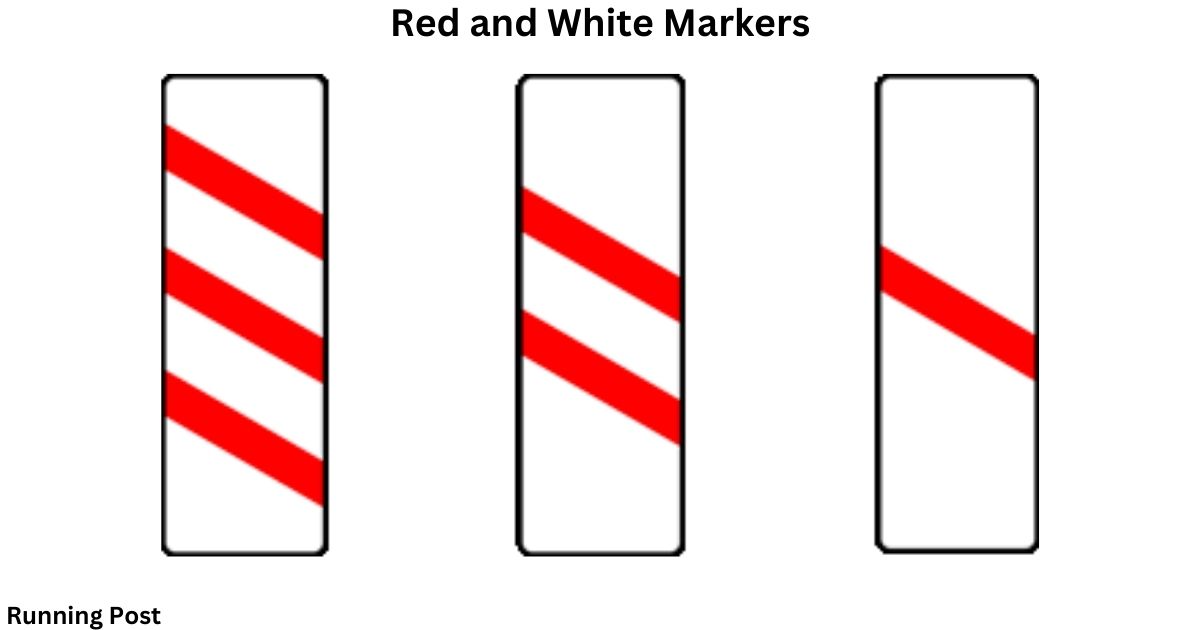| A: Red and white markers are found on pedestrian crosswalks | B: Approaching a concealed level crossing | C: Approaching the end of a dual carriageway | D: These markers are typically used for highway speed limits |
Introduction
Overview of Road Markers
Road markers are essential elements of traffic management that guide and inform drivers. They include lane markings, pedestrian crossings, and directional arrows. Each type of marker serves a unique purpose:
- Lane Markings: These define the boundaries of lanes to keep traffic organized.
- Pedestrian Crossings: Indicate where it is safe for pedestrians to cross.
- Directional Arrows: Provide guidance on turning or continuing straight.
Understanding these markers is critical for safe driving because they convey important information about road conditions, rules, and potential hazards. Proper comprehension and adherence to these markers help ensure smoother traffic flow and prevent accidents.
Points:
- Road markers guide and inform drivers.
- Types include lane markings, pedestrian crossings, and directional arrows.
- They help in maintaining traffic order and safety.
Importance of Understanding Road Markers for Safety
Recognizing and interpreting road markers correctly is vital for preventing accidents. Road markers are designed to alert drivers to specific conditions or rules, such as lane changes, speed limits, or upcoming hazards. For example:
- Lane Markings: Prevent lane drifting and maintain orderly traffic flow.
- Speed Limits: Indicate the maximum speed allowed to ensure safety.
- Warning Signs: Alert drivers to hazards such as sharp turns or pedestrian crossings.
By understanding these markers, drivers can make informed decisions, avoid dangerous situations, and enhance overall road safety.
Points:
- Correct interpretation prevents accidents.
- Road markers signal conditions and rules.
- They help in making informed driving decisions.
Where Will You See These Red and White Markers?
Concealed Level Crossings
Red and white markers are prominently used at concealed level crossings. These crossings are hidden from view due to road bends, curves, or obstacles, making them particularly dangerous. The markers are strategically placed to:
- Warn Drivers: Indicate that a hidden crossing is ahead.
- Promote Caution: Urge drivers to slow down and be alert for trains.
By using red and white markers, authorities provide an early warning system that helps drivers anticipate potential risks and prepare for safe crossing.
Points:
- Markers are used at concealed level crossings.
- They alert drivers to hidden dangers.
- They encourage drivers to be cautious and slow down.
Purpose of Red and White Markings
Indicating Potential Hazards
Red and white markings are designed to signal potential hazards on the road. The red color typically represents danger, while the white color adds contrast to make the markers more visible. These markers are used to:
- Highlight Danger Areas: Indicate where drivers need to be particularly careful.
- Prevent Accidents: Alert drivers to potential hazards like sharp turns or hidden crossings.
By clearly marking hazardous areas, these markers help drivers recognize and avoid potential dangers before they become critical.
Points:
- Red and white markers indicate danger.
- They highlight areas requiring caution.
- They help prevent accidents by alerting drivers to hazards.
Enhancing Driver Awareness
Red and white markers significantly enhance driver awareness by providing clear visual cues about upcoming hazards. This heightened awareness allows drivers to:
- Improve Reaction Times: Prepare for unexpected conditions in advance.
- Reduce Accident Risk: Take appropriate actions to avoid collisions.
For example, at a concealed level crossing, these markers give drivers advance notice to slow down and be ready to stop if necessary, thus reducing the risk of accidents.
Points:
- Markers improve driver reaction times.
- They help in reducing accident risks.
- They provide advance notice of hazards.
What Are Countdown Markers?
Definition and Use
Countdown markers are road markings that show the distance or time remaining before reaching a specific point, such as a level crossing or traffic signal. They are used to:
- Provide Visual Cues: Indicate how much distance is left before reaching a hazard.
- Help Drivers Prepare: Allow time for necessary actions, like slowing down.
These markers complement red and white markers by offering additional information on how close drivers are to potential hazards.
Points:
- Countdown markers show remaining distance or time.
- They provide visual cues for upcoming points of interest.
- They help drivers prepare in advance.
You Also Like It:
What’s a Statutory Off-Road Notification (SORN)?
How can you identify traffic signs that give orders?
What’s the speed limit for a car towing a small caravan along a dual carriageway?
Color Markings for Hidden Level Crossings
Warning Colors
Different colors are used to warn drivers of hidden level crossings. Typically:
- Red Markings: Indicate danger or a need to stop.
- White Markings: Provide contrast to make the red markings more noticeable.
These colors help differentiate the warning markers from other road signs and ensure that drivers are alerted to the presence of a hidden level crossing.
Points:
- Red and white are used to warn of hidden crossings.
- Red indicates danger, while white adds contrast.
- Colors help make the markers stand out.
Conclusion
Summary of Key Points
In summary, red and white markers are used primarily at concealed level crossings to alert drivers of potential hidden dangers. They serve to:
- Warn of Hidden Hazards: Indicate areas where visibility is reduced.
- Enhance Safety: Provide early warnings to help prevent accidents.
Understanding these markers and their purpose is essential for safe driving and effective hazard management.
Points:
- Red and white markers alert to hidden hazards.
- They enhance road safety through early warnings.
- Understanding their purpose is crucial for safe driving.
Importance of Compliance
Compliance with road markers is crucial for maintaining safety on the roads. Drivers should:
- Adhere to Warnings: Follow the indications given by red and white markers.
- Be Cautious: Always be prepared for potential hazards, especially at concealed level crossings.
By respecting road markers and signs, drivers contribute to a safer driving environment and reduce the risk of accidents.
Points:
- Compliance with markers ensures road safety.
- Drivers should follow warnings and be cautious.
- Respecting road signs helps prevent accidents.
FAQs About Where will you see these red and white markers?
What do red and white markers indicate?
Red and white markers are commonly used to indicate potential hazards, particularly at concealed level crossings. The red color signals danger or a need to stop, while the white provides contrast to ensure visibility. These markers alert drivers to upcoming risks that may not be immediately visible due to road bends or obstructions.
Points:
- Red indicates danger or the need to stop.
- White provides contrast and improves visibility.
- Used mainly at concealed level crossings.
Why are concealed level crossings dangerous?
Concealed level crossings are dangerous because they are hidden from view, often due to road curves, obstructions, or terrain. Drivers may not see an approaching train until it’s too late, increasing the risk of collisions. The use of red and white markers helps to mitigate these risks by providing advance warning to drivers.
Points:
- Concealed level crossings are hidden from view.
- They increase collision risk with trains.
- Red and white markers provide advance warnings.
How do countdown markers assist drivers?
Countdown markers assist drivers by indicating the distance or time remaining before reaching a particular point, such as a level crossing or traffic signal. This allows drivers to prepare in advance, such as by slowing down or being ready to stop, thus improving safety and reducing the likelihood of accidents.
Points:
- Show remaining distance or time.
- Allow drivers to prepare in advance.
- Improve safety and reduce accident risk.
What are the colors used for hidden level crossings?
For hidden level crossings, the primary colors used are red and white. Red markers indicate danger or the need to stop, while white provides a contrasting background to ensure the markers are easily visible. This color combination is designed to grab drivers’ attention and alert them to potential hazards.
Points:
- Red and white are used for hidden level crossings.
- Red indicates danger; white provides contrast.
- Ensures markers are easily visible.
H4: Why is it important to follow road markers?
Following road markers is crucial for maintaining safety on the roads. They provide essential information about road conditions, potential hazards, and traffic rules. Adhering to these markers helps prevent accidents, ensures smooth traffic flow, and promotes overall road safety.
Points:
- Road markers provide essential safety information.
- Following them prevents accidents.
- Ensures smooth traffic flow and safety.
You Also Like It:
What will happen if your car’s wheels are unbalanced?
Releated Posts
MAB Instructor Certification: Your Gateway to Professional Crisis Management Leadership
In today’s fast-evolving professional environments—especially in healthcare, mental health, education, and corrections—conflict and aggression can arise without warning.…
Freewayget.com: Your Ultimate Platform for Deals, Discounts, and Digital Products
Introduction to Freewayget.com In today’s fast-paced digital world, finding reliable platforms that offer authentic discounts, deals, and digital…
Affordable & Fast Embroidery Digitizing Services in Your Area
Embroidery digitizing services provide corporations, designers, and people with brilliant embroidery-equipped designs by means of changing art work…
Introduction to hdhub4u nit
In this article, we will delve into the details of hdhub4u nit, exploring its features, benefits, and why…

















